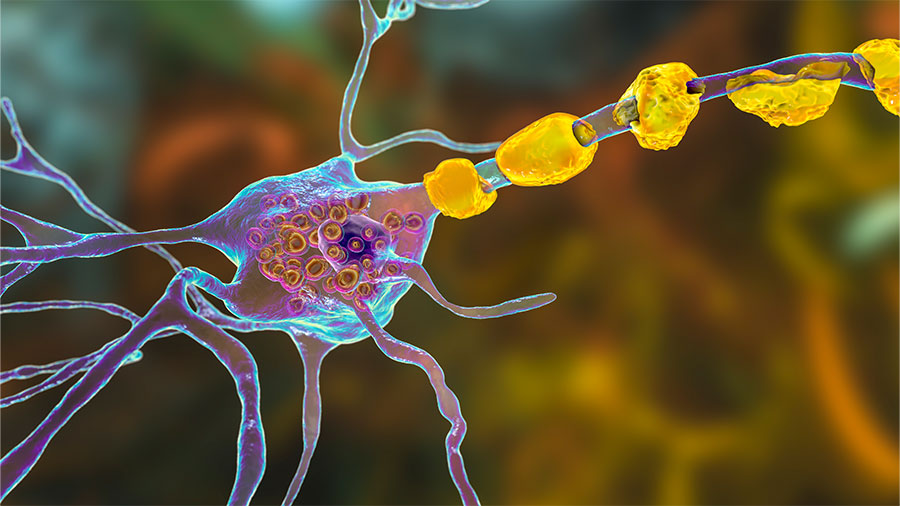Understanding the cause of childhood Alzheimer's
Our body is constantly making macromolecules for specific purposes, but what happens when they’re no longer needed? This is where the function of the lysosome comes in. The job of the lysosome is to break down old organelles and macromolecules. When it cannot function normally, it causes a buildup of debris in cells that lead to damage. There are over 50 lysosomal storage disorders that can affect a variety of body tissues.
Sanfilippo syndrome, also known as mucopolysaccharidosis type III, is one such disease. In Sanfilippo syndrome, the affected children are lacking one of the enzymes that help break down glycosaminoglycans, or GAGs. This leads to accumulation in the brain and spinal cord that leads to neurodegeneration. Symptoms often include an altered mental state, which is why Sanfilipo is also known as childhood Alzheimer’s.
Today is World Sanfilippo Awareness Day. This observance exists to raise awareness of the disease, to help connect affected families, and to spur research into treatments and cures.
It is estimated that one in 70,000 children are born with Sanfillipo. Symptoms are often not noticed until the children are between 1 and 6 years of age and begin to experience noticeable developmental delays. It has a 100% fatality rate, with most patients dying as teenagers.

The genetics
Name origin

In 1963, Dr. Sylvester Sanfillipo presented information about a patient at the American Pediatric Society Annual Meeting. This was the first time it had been officially described and the condition is now named after him.
Sanfillipo is autosomal recessive. Children impacted have inherited two copies of a mutation in a gene that produces an enzyme that helps with breaking down GAGs. There are four types of Sanfilippo: Type A, B, C and D. A different gene is mutated in each type.
Type A is the most common and most severe type.It is caused by a mutation in SGSH. This mutation leads to the loss or improper functioning of heparan N-sulfatase.
Type B is caused by a mutation in NAGLU, leading to the loss or improper functioning of the enzyme alpha-N-acetylglucosaminidase.
Type C is caused by a mutation in HGSNAT, leading to loss or improper functioning of acetyl-CoA:alpha-glucosaminide N-acetyltransferase.
Type D is the most rare. It is caused by a mutation in GNS which leads to loss or improper functioning of N-acetylglucosamine 6-sulfatase.
Symptoms
Each child with Sanfillipo will present differently depending on the type of mutation causing their condition.
Early in life, the child typically follows a normal developmental trajectory. Eventually, the child begins to steeply decline, often around the age of 1 or 2. The child will lose any words they knew and eventually develop seizures and lack of mobility. Other common symptoms include: behavioral difficulties, coarse facial features, enlarged liver and spleen, vision problems, hearing loss, joint stiffness and regression of developmental skills.
In all cases, the disease will eventually result in death, usually prior to reaching adulthood.
The challenge and potential of treatment
At this time, there are no cures or treatments for Sanfillipo. All medical interventions are related to treating the symptoms and trying to make the child comfortable.
Finding ways to treat and slow down the progression of Sanfillipo is difficult. Its location in the central nervous system presents one significant challenge. It is hard to get drugs or delivery systems through the blood–brain barrier. Furthermore, once neurodegeneration has occurred, it is hard to reverse it, so treatment needs to start early.
Sanfillipo is a rare disease, so clinical trials often have a small number of participants that may be at different disease stages. This makes it hard to be certain that the treatment is offering benefit.
Despite these challenges, scientists are dedicated, and there is extensive research being done in the hopes of improving the quality of life of patients. The three main areas being investigated are enzyme replacement therapy, gene replacement and substrate reduction therapy.
Substrate reduction therapy: This area is focused on reducing the amount of GAGs produced. GAGs cannot be broken down in Sanfilippo, so reducing their production can help reduce the damage accumulation causes. Studies in mice have shown promise, but human clinical trials have not yet confirmed the benefit of this treatment.
Enzyme replacement therapy: In ERT, the focus is on administering functional enzymes to make up for the deficit caused by the inherited mutation. ERT has been used for other lysosomal storage disorders with promising results. However, the challenge with Sanfillipo is its impact on the CNS, to which it’s hard to deliver enzyme replacement. To try to circumvent this hurdle, in vivo studies have focused on direct injection into the CNS. This method has shown success in mouse models.
Gene therapy: Treatments using gene therapy aim to correct the problem at its source by delivering a functioning copy of the gene into the CNS. An extensive body of work is being done to determine what viral vector system does this the best. Early clinical trial data has produced promising results with some improved symptoms and slowing of disease progression. Many trials are ongoing.
Currently none of these treatments is authorized by the Food and Drug Administration, but the research continues with the hopes of eventually having ways of extending the lifespan and health of these patients.
Enjoy reading ASBMB Today?
Become a member to receive the print edition four times a year and the digital edition monthly.
Learn moreGet the latest from ASBMB Today
Enter your email address, and we’ll send you a weekly email with recent articles, interviews and more.
Latest in Science
Science highlights or most popular articles

Exploring the link between lipids and longevity
Meng Wang will present her work on metabolism and aging at the ASBMB Annual Meeting, March 7-10, just outside of Washington, D.C.

Defining a ‘crucial gatekeeper’ of lipid metabolism
George Carman receives the Herbert Tabor Research Award at the ASBMB Annual Meeting, March 7–10, just outside of Washington, D.C.

The science of staying strong
Muscles power every movement, but they also tell the story of aging itself. Scientists are uncovering how strength fades, why some species resist it and what lifestyle and molecular clues could help preserve muscle health for life.

Bacteriophage protein could make queso fresco safer
Researchers characterized the structure and function of PlyP100, a bacteriophage protein that shows promise as a food-safe antimicrobial for preventing Listeria monocytogenes growth in fresh cheeses.

Building the blueprint to block HIV
Wesley Sundquist will present his work on the HIV capsid and revolutionary drug, Lenacapavir, at the ASBMB Annual Meeting, March 7–10, in Maryland.

Gut microbes hijack cancer pathway in high-fat diets
Researchers at the Feinstein Institutes for Medical Research found that a high-fat diet increases ammonia-producing bacteria in the gut microbiome of mice, which in turn disrupts TGF-β signaling and promotes colorectal cancer.

